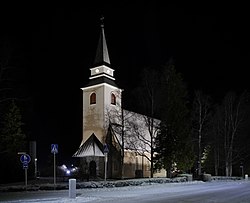
Summary
Alavieska (Finnish pronunciation: [ˈɑlɑˌʋie̯skɑ]) is a municipality of Finland. It is located in the province of Oulu and is part of the Northern Ostrobothnia region. The municipality has a population of 2,435 (31 December 2023)[2] and covers an area of 253.02 square kilometres (97.69 sq mi) of which 1.66 km2 (0.64 sq mi) is water.[1] The population density is 9.68 inhabitants per square kilometre (25.1/sq mi).
Alavieska | |
|---|---|
Municipality | |
| Alavieskan kunta Alavieska kommun | |
 The Alavieska Church | |
 Coat of arms | |
 Location of Alavieska in Finland | |
| Coordinates: 64°10′N 024°18.5′E / 64.167°N 24.3083°E | |
| Country | |
| Region | North Ostrobothnia |
| Sub-region | Ylivieska |
| Charter | 1879 |
| Government | |
| • Mayor | Kari Pentti |
| Area (2018-01-01)[1] | |
| • Total | 253.02 km2 (97.69 sq mi) |
| • Land | 251.5 km2 (97.1 sq mi) |
| • Water | 1.66 km2 (0.64 sq mi) |
| • Rank | 245th largest in Finland |
| Population (2023-12-31)[2] | |
| • Total | 2,435 |
| • Rank | 239th largest in Finland |
| • Density | 9.68/km2 (25.1/sq mi) |
| Population by native language | |
| • Finnish | 98.9% (official) |
| • Swedish | 0.2% |
| • Others | 0.9% |
| Population by age | |
| • 0 to 14 | 19.3% |
| • 15 to 64 | 55.8% |
| • 65 or older | 24.9% |
| Time zone | UTC+02:00 (EET) |
| • Summer (DST) | UTC+03:00 (EEST) |
| Website | www.alavieska.fi |
The municipality is unilingually Finnish. The word Ala means "lower", while the word Vieska is supposed to mean a "shallow ford".[6]
The scythe theme of Alavieska's coat of arms refers to the extensive meadows in the municipality's territory. The coat of arms was designed by Kaj Kajander, and the Alavieska municipal council approved it at its meeting on September 20, 1960. The Ministry of the Interior approved the coat of arms for use on November 25 of the same year.[7][8]
Geography edit
Neighbouring municipalities are Kalajoki, Merijärvi, Oulainen and Ylivieska.
Villages edit
In 1967, Alavieska had six legally recognized villages (henkikirjakylät):[9]
- Alavieska
- Eteläranta
- Kähtävä
- Somero
- Taluskylä
- Käännänkylä
Demographics edit
In 2020, 19.3% of the population of Alavieska was under the age of 15, 55.8% were aged 15 to 64, and 24.9% were over the age of 64. The average age was 43.8, above the national average of 43.4 and regional average of 40.8. Speakers of Finnish made up 99.0% of the population and speakers of Swedish made up 0.2%, while the share of speakers of foreign languages was 0.8%. Foreign nationals made up 0.6% of the total population.[10]
The chart below, describing the development of the total population of Alavieska from 1975-2020, encompasses the municipality's area as of 2021.
|
| ||||||||||||||||||||||||||||||||||||
| Source: Statistics Finland[11] | |||||||||||||||||||||||||||||||||||||
Urban areas edit
In 2019, out of the total population of 2,519, 1,281 people lived in the sole urban area, the Alavieska parish village, while lived 1,220 in sparsely populated areas and the coordinates of 18 people were unknown. This made Alavieska's degree of urbanization 51.2%.[12][13]
Economy edit
In 2018, 23.1% of the workforce of Alavieska worked in primary production (agriculture, forestry and fishing), 22.4% in secondary production (e.g. manufacturing, construction and infrastructure), and 52.9% in services. In 2019, the unemployment rate was 8.8%, and the share of pensioners in the population was 29.5%.[14]
Notable people edit
- Pentti Kahma, discus thrower
- Teemu Kattilakoski, skier
- Rauli Pudas, pole vaulter
See also edit
References edit
- ^ a b "Area of Finnish Municipalities 1.1.2018" (PDF). National Land Survey of Finland. Retrieved 30 January 2018.
- ^ a b "Immigration record high in Finland in 2023". StatFin. Statistics Finland. Retrieved 25 January 2024.
- ^ "Demographic Structure by area as of 31 December 2022". Statistics Finland's PX-Web databases. Statistics Finland. Retrieved 6 September 2023.
- ^ "Population according to age (1-year) and sex by area and the regional division of each statistical reference year, 2003–2020". StatFin. Statistics Finland. Retrieved 2 May 2021.
- ^ a b "Luettelo kuntien ja seurakuntien tuloveroprosenteista vuonna 2023". Tax Administration of Finland. 14 November 2022. Retrieved 7 May 2023.
- ^ Rahkonen, Pauli (2013). "Suomen etymologisesti läpinäkymätöntä vesistönimistöä". Virittäjä (in Finnish). No. 1. p. 21.
- ^ Suomen kunnallisvaakunat (in Finnish). Suomen Kunnallisliitto. 1982. p. 126. ISBN 951-773-085-3.
- ^ "Sisäasiainministeriön vahvistamat kaupunkien, kauppaloiden ja kuntien vaakunat 1949-1995 I:8 Alavieska" (in Finnish). Kansallisarkiston digitaaliarkisto. Retrieved July 28, 2022.[permanent dead link]
- ^ Maijala, Veikko; Papunen, Pentti (1967). "Alavieska". Suomenmaa: maantieteellis-yhteiskunnallinen tieto- ja hakuteos. 1: Ahlainen–Hausjärvi. Helsinki: WSOY.
- ^ "Key figures on population by region, 1990-2020". StatFin. Statistics Finland. Archived from the original on 2019-04-06. Retrieved 28 April 2021.
- ^ "Population according to age (1-year) and sex by area, 1972-2020". StatFin. Statistics Finland. Archived from the original on 2019-05-25. Retrieved 28 April 2021.
- ^ "Degree of urbanisation by area, 2019". StatFin. Statistics Finland. Archived from the original on 2019-11-26. Retrieved 28 April 2021.
- ^ "Population in urban settlements and sparsely populated areas by age, sex and municipality, 2019". StatFin. Statistics Finland. Archived from the original on 2019-11-26. Retrieved 28 April 2021.
- ^ "Municipal key figures 1987-2020 (with the 2021 regional division)". StatFin. Statistics Finland. Archived from the original on 2021-04-26. Retrieved 28 April 2021. (2018 and 2019)
External links edit
- Media related to Alavieska at Wikimedia Commons
- Municipality of Alavieska – Official website (in Finnish)


